The NASA Electronic Parts and Packaging (NEPP) '02 Workshop
The NASA Electronic Parts and Packaging (NEPP) '02 Workshop
The NASA Electronic Parts and Packaging (NEPP) '02 Workshop
You also want an ePaper? Increase the reach of your titles
YUMPU automatically turns print PDFs into web optimized ePapers that Google loves.
Abstracts ________________________<br />
encompass temperatures as low as -183 °C. <strong>The</strong> development <strong>and</strong><br />
utilization of electronics capable of low temperature operation<br />
would not only fulfill the advanced technology requirements, but<br />
also would contribute to improving circuit performance, increasing<br />
system efficiency, <strong>and</strong> reducing development <strong>and</strong> launch costs.<br />
<strong>The</strong>se benefits are generally achieved by the improved intrinsic<br />
properties of some of the electronic materials at low temperature,<br />
reduced device losses, <strong>and</strong> the elimination of heating elements<br />
used in conventional systems at low temperatures. Power<br />
electronic circuits are widely used in space power systems in the<br />
areas of power management, conditioning, <strong>and</strong> control. In this<br />
work, the performance of certain power electronic components <strong>and</strong><br />
systems was investigated under low temperature. <strong>The</strong>se include<br />
inductors, capacitors, pulse-width-modulation (PWM) controllers,<br />
<strong>and</strong> advanced commercial DC/DC converter modules. Different<br />
properties were determined as a function of temperature in the<br />
range of 20 °C to - 140 °C, at various current <strong>and</strong> voltages levels.<br />
<strong>The</strong> experimental procedures along with the experimental data<br />
obtained are presented <strong>and</strong> discussed in this paper.<br />
Speaker Biography<br />
Malik Elbuluk is a professor of electrical engineering at <strong>The</strong><br />
University of Akron, Oh where he has been since 1989. He was<br />
also a member of the faculty at North Carolina State University<br />
from 1986-1989. He obtained his MS <strong>and</strong> D.Sc. in electrical<br />
engineering from MIT. His teaching <strong>and</strong> research interests are in<br />
the areas of power electronics <strong>and</strong> application of control systems to<br />
power <strong>and</strong> motion control. He has participated in a number of<br />
research projects at <strong>NASA</strong> Glenn Research Center including Low<br />
Temperature <strong>Electronic</strong>s, Power-by-Wire, More-Electric Aircraft,<br />
<strong>and</strong> Power <strong>Electronic</strong> Building Blocks.<br />
He a senior member of IEEE <strong>and</strong> is an associate editor of the IEEE<br />
Transactions on Power <strong>Electronic</strong>s.<br />
Ge-Based Semiconductor Devices for Cryogenic Power<br />
<strong>Electronic</strong>s<br />
R.R. Ward * <strong>and</strong> W.J. Dawson: GPD Optoelectronics Corp., Salem,<br />
NH<br />
R.K. Kirschman: Consulting Physicist, Mountain View, CA<br />
O. Mueller: LTE – Low Temperature <strong>Electronic</strong>s, Ballston Lake,<br />
NY<br />
R.L. Patterson <strong>and</strong> J.E. Dickman: <strong>NASA</strong> Glenn Research Center,<br />
Clevel<strong>and</strong>, OH 44135<br />
A. Hammoud: QSS Group, Inc., <strong>NASA</strong> Glenn Research Center,<br />
Clevel<strong>and</strong>, OH 44135<br />
Abstract<br />
<strong>NASA</strong>'s plans to explore remote bodies in the Solar System will<br />
subject spacecraft <strong>and</strong> surface craft to environmental temperature<br />
extremes. For example, calculations indicate about 120 K (-150 °C)<br />
at the orbit of Jupiter <strong>and</strong> about 44 K (-230 °C) at the orbit of Pluto.<br />
Even the moon, Mars, <strong>and</strong> asteroids can subject surface craft to<br />
temperatures well below the conventional limit for electronic parts<br />
of -55/-65 °C.<br />
Incorporating thermal control into spacecraft <strong>and</strong> surface craft to<br />
maintain electronic systems within the conventional temperature<br />
range of –55 °C to +125 °C will become increasingly less desirable<br />
<strong>and</strong> less practical. Elimination of thermal control would provide<br />
23<br />
important benefits including decreased mass, size, complexity <strong>and</strong><br />
power requirements. This would also result in reduced<br />
development time-<strong>and</strong>-effort <strong>and</strong> launch costs, as well as extended<br />
mission operations for longer observation or exploration time. Thus<br />
there are strong reasons to allow the electronics <strong>and</strong> other systems<br />
to assume a temperature near that of the environment, in other<br />
words to operate "cold."<br />
To address the need for "cold" electronics, we have been<br />
investigating <strong>and</strong> developing semiconductor devices (diodes <strong>and</strong><br />
transistors) specifically for use in cryogenic power conversion <strong>and</strong><br />
conditioning circuitry as well as for driver circuitry (for motors or<br />
actuators). Because of the particular requirements of the <strong>NASA</strong><br />
applications, we are using germanium (Ge) in the development of<br />
these semiconductor devices. Our investigations confirm that Ge<br />
devices, including diodes, junction field-effect transistors, <strong>and</strong><br />
bipolar transistors, can operate over the entire cryogenic<br />
temperature range of interest (down to about 20-30 K). We are also<br />
proposing to develop cryogenic devices based on the silicongermanium<br />
(SiGe) semiconductor materials system because of its<br />
compatibility with existing Si device fabrication <strong>and</strong> its greater<br />
design flexibility afforded by b<strong>and</strong>-gap engineering.<br />
*Also: Consulting physicist, Mountain View, California, U.S.A.<br />
Speaker Biography<br />
Rufus Ward received the B. S. in Engineering from Swarthmore<br />
College in 1987 <strong>and</strong> the M. S. in Electrical Engineering from Duke<br />
University in 1990. His Master's thesis research was modeling the<br />
effects of heavy substrate doping on the growth rate of thermally<br />
grown silicon dioxide. He is a member of Eta Kappa Nu.<br />
From 1990 to 2000 he was an engineer at Germanium Power<br />
Devices Corp. in Andover, Massachusetts <strong>and</strong> is currently Vice<br />
President, Engineering at GPD Optoelectronics Corp. (the new<br />
name of Germanium Power Devices Corp.). He has worked on<br />
research, development <strong>and</strong> production of Germanium Schottky<br />
diodes, Germanium transistors <strong>and</strong> photodetectors, <strong>and</strong> InGaAs<br />
photodetectors. He served as Principal Investigator on a Phase I<br />
<strong>and</strong> Phase II SBIR project, entitled "Low-Noise Cryogenic<br />
Germanium Field-Effect Transistor."



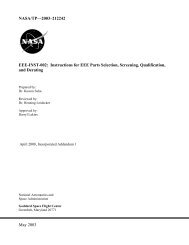

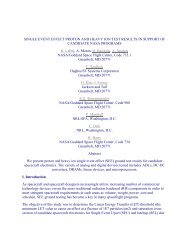
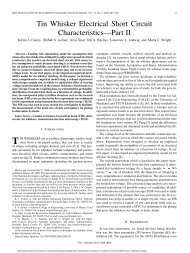
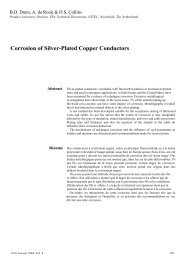
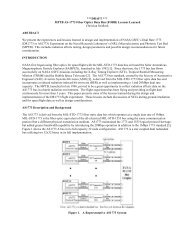

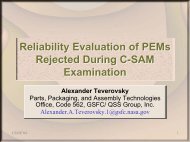
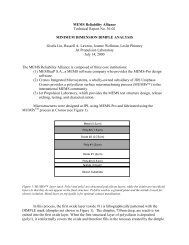
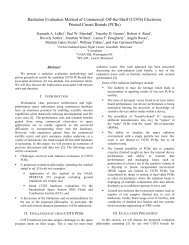
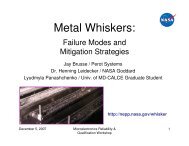
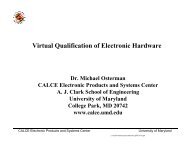
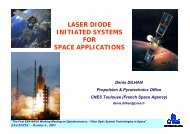
![mil-std-2223 [test methods for insulated electric wire] - NEPP](https://img.yumpu.com/4036001/1/190x249/mil-std-2223-test-methods-for-insulated-electric-wire-nepp.jpg?quality=85)